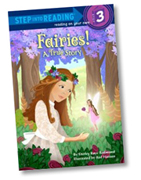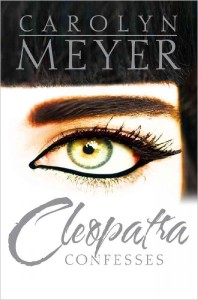This is part of a series of interviews with New Mexico children’s writers to celebrate the 2012 centennial. (1)
 Lauren Bjorkman (2)is the author of My Invented Life (Henry Holt , 2009), a YA novel that takes on sibling relationships, sexual identity, and Shakespeare, all through the voice of cynical-yet-daydreaming teen theatre geek Roz. PW called it “fun, thought-provoking reading,” and I have to agree. Welcome, Lauren!
Lauren Bjorkman (2)is the author of My Invented Life (Henry Holt , 2009), a YA novel that takes on sibling relationships, sexual identity, and Shakespeare, all through the voice of cynical-yet-daydreaming teen theatre geek Roz. PW called it “fun, thought-provoking reading,” and I have to agree. Welcome, Lauren!
Roz has such a strong voice, and she’s such a believable mix of self-awareness and denial. How did you develop her voice in writing My Invented Life?
I started with a picture in my mind—a big, adorable dog that wants to be loved, but doesn’t know how to behave around people. To that, I added some observations I’d made of a young woman in my hometown, a talented actress with a big heart and boundless energy. Once Roz came alive for me, everything I wrote went through the Roz-o-matic filter—would Roz do this? Would Roz say that? It was great fun to create someone so unlike myself.
The plot of My Invented Life models the play, As You Like It, that the theatre geeks are practicing. How did that come about? Were you planning from the start to use Shakespeare? If you had to introduce Shakespeare to teens using a different play, which would it be?
I started with my sisters, and the secret that divides them. Then I fleshed out my characters and designed a rudimentary plot. When I shared my thoughts with my critique group, one talented writer said, “Your plot sounds like a Shakespearean play, where everyone is pretending to be someone else. I’d seen As You Like It in high school, and re-read it. That gave me an insight—Roz had all the hallmarks of an actress. So I transformed her into one.
First off, I’m no expert on education. But I remember my own experience struggling with Shakespeare in high school. Hating it, to be honest. So here are my recommendations based on n=1.
- Read the play aloud in class, stopping to interpret the language at every turn. Switch roles, so everyone gets a turn to read.
- Let your students watch a theatrical or movie version of the play.
- Romeo and Juliet is a good choice because it has both romance and swordplay, and therefore broad appeal.
Stories like Roz’s let readers into the mind of someone who is questioning all kinds of things: sexuality, loyalty, friendship, self-worth. What do you hope readers will take away from reading My Invented Life and other books with similar themes?
For me, reading is often about taking a look at life through new eyes (while being entertained, of course!). Who in the story can I identify with most? What would I do in the main character’s shoes? I want my readers to be surprised, and, if they don’t quite fit in, to feel less alone. My story is celebration of our differences.
In my next novel, Miss Fortune Cookie, about a teen advice blooger, my characters are not LGBT. Still, when a gay hate group pickets their school, they organize an event—a sort of modern day love-in/dance party—to counter-act the hate.
I heard you speak at a bookstore event with Malinda Lo, Alexandra Diaz, Megan Frazer, and Kristin Cronn-Mills on LGTBQ youth literature (3). That was 2010; what do you think of the state of things today? What are some of your favorite recent books for teens on LGTBQ issues?
What a fun event! Sadly, the issues around bullying of LGBTQ teens haven’t diminished, but the number of teen LGBTQ novels published each year continues to grow. More schools have Gay-Straight Alliances than ever before. I adore the It Gets Better Project , and feel optimistic about the future.
I haven’t kept up with my TBR this year because of building a house, and then moving in! That said, I managed to read and fall in love with Will Grayson Will Grayson.
Kirstin Cronn-Mills has a new novel about a trans character coming out in October, Beautiful Music for Ugly Children–Love, transition, violence—mix with music, and broadcast on the radio. Not your typical teenage life.
Malinda Lo’s new YA science-fiction thriller called Adaptation will be released in September. Reese can’t remember anything from the time between the accident and the day she woke up almost a month later. She only knows one thing: She’s different now.
What is the best part about writing for teens? Have you heard anything from a teen reader that really made your day?
For me, it’s all about fame and fortune. Just kidding! The best part is making connections with teens. It’s great when someone is crazy about my book, of course, but sometimes a teen just needs someone to talk to or take an interest in his or her writing. I love that part too.
Here are a couple fave reactions: One reader wrote that she sighed and hugged my book after finishing it, like it had become a friend. Another chose my My Invented Life as the next Great American Novel for a class assignment, which cracked me up, and made my day.
The professor’s question (in honor of Vaunda Nelson’s great-uncle, who started a bookstore with fivebooks): If you had to start a bookstore with just fivebooks, which five would you choose? These aren’t necessarily your five favorite desert island books, but the five you most want to share with the world.
Hard question! I’m kind of fickle. My favorite books change all the time, depending on what I’m reading.
So I’ll recommend my favorite classics, plus one amazing graphic novel:
To Kill a Mockingbird by Harper Lee
Emma by Jane Austen
East of Eden by John Steinbeck
Jane Eyre by Charlotte Bronte
American Born Chinese by Gene Luen Yang
Are there any excellent Shakespearean curses that didn’t make it into My Invented Life?
Go read a book, thou infectious clapper-clawed pignut!
Good advice! Thank you, Lauren, for this interview!
1. For more interviews with NM children’s writers, go here.
2. Visit Lauren’s website.
3. Malinda Lo. Alexandra Diaz. Megan Frazer. Kristin Cronn-Mills.
















